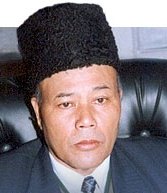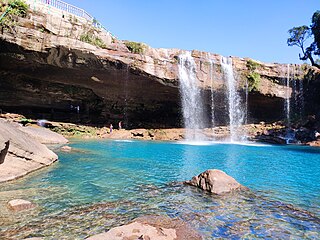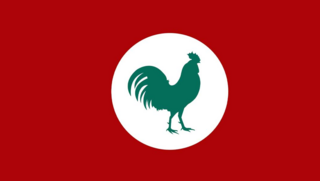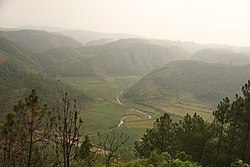
Meghalaya is a state in northeast India. Meghalaya was formed on 21 January 1972 by carving out two districts from the state of Assam: (a) the United Khasi Hills and Jaintia Hills and (b) the Garo Hills. The population of Meghalaya as of 2014 is estimated to be 3,211,474. Meghalaya covers an area of approximately 22,429 square kilometres, with a length-to-breadth ratio of about 3:1.

Shillong is a hill station and the capital of Meghalaya, a state in northeastern India. It is the headquarters of the East Khasi Hills district. Shillong is the 330th most populous city in India with a population of 143,229 according to the 2011 census. It is said that the rolling hills around the town reminded the British of Scotland. Hence, they would also refer to it as the "Scotland of the East".

The Khasi people are an ethnic group of Meghalaya in north-eastern India with a significant population in the bordering state of Assam, and in certain parts of Bangladesh. Khasi people form the majority of the population of the eastern part of Meghalaya, that is Khasi Hills, constituting 78.3% of the region's population, and is the state's largest community, with around 48% of the population of Meghalaya. They are among the few Austroasiatic-speaking peoples in South Asia. The Khasi tribe holds the distinction of being one of the few remaining matriarchal tribes of the world. Under the Constitution of India, the Khasis have been granted the status of Scheduled Tribe.

East Khasi Hills is an administrative district in the state of Meghalaya in India. The district headquarters are located at Shillong. The district occupies an area of 2752 km² and has a population of 825,922. As of 2011, it is the most populous district of Meghalaya's 12 districts.
Shri Hoping Stone Lyngdoh was an Indian politician who was the president of the Hill State People's Democratic Party (HSPDP), one of three official political parties of the state of Meghalaya in India. He was the son of late Hajur Shon; was born at Nonglait Village, West Khasi Hills District on March 15, 1929; he studied at St. Anthony's College, Shillong.

The Meghalaya subtropical forests is an ecoregion of Northeast India. The ecoregion covers an area of 41,700 square kilometers (16,100 sq mi), and despite its name, comprise not only the state of Meghalaya, but also parts of southern Assam, and a tiny bit of Nagaland around Dimapur and adjacent Bangladesh. It also contains many other habitats than subtropical forests, but the montane subtropical forests found in Meghalaya is an important biome, and was once much more widespread in the region, and for these reasons chosen as the most suitable name. The scientific designation is IM0126.
The Roman Catholic Diocese of Nongstoin is a diocese located in the city of Nongstoin in the Ecclesiastical province of Shillong in India. In a land area of 5, 247 square kilometers, the diocesan territory covers the West Khasi Hills, Eastern West Khasi Hills and South West Khasi Hills District of Meghalaya state.
George Gilbert Swell was a college professor, an Indian politician, an ambassador to several countries, a former Deputy Speaker of the Lok Sabha and its member from Shillong in Meghalaya. Over a span of more than 35 years, he represented India at high levels nationally and internationally. Though arising from a modest and rural background in far Northeast India, Swell quickly rose to prominence in every field he entered.
Brington Buhai Lyngdoh or B. B. Lyngdoh was former Chief Ministers of Meghalaya, a state in north-eastern India. He was born at Laitlyngkot, a village twenty-five kilometres away from Shillong, on 2 February 1922. He is one of India's most well known statesman and is often referred to as the 'Father of coalition politics'. B. B. Lyngdoh was one of the prominent leaders on Meghalaya's Hills State movement.
Leptolalax khasiorum is a species of frogs belonging to the genus Leptolalax. It is so far reported only from the type locality, from the subtropical wet forests of Mawphlang in Khasi Hills, Meghalaya, India. It is a small amphibian; the male measuring 25.6 mm, and female 32.5 mm. The species is diagnosed with unique features such as eyelids with tubercles, distinct tympanum and supratympanic folds, undilated toe tips with dermal fringes, dorsum with dark blotches, flanks with large dark blotches, dark tympanic mask, limbs with dark cross-bars, and distinct color patches.
Dr. H. Gordon Roberts Hospital, Shillong, or KJP Hospital, is one of the oldest medical centres in Meghalaya. This Christian institution was founded by Dr. Hughes Gordon Roberts and is located in the city of Shillong in the north east of India.

Dr. Flinder Anderson Khonglam was an Indian politician and physician. He served as the eighth Chief Minister of Meghalaya from 2001 to 2003. Khonglam was the first independent legislator to serve as the Chief Minister of any Indian state in history.
Evansius Kek Mawlong was an Indian politician who served as the Chief Minister of Meghalaya from 8 March 2000, until 8 December 2001. He was the main architect in the formation of the United Democratic Party in Meghalaya and was its Founding President.
William Williams was a Welsh Presbyterian missionary to Khasi Hills, northeast India, in the late 19th century. He was a son of a ship captain in Nanternis, a small village in Wales. Following his father's footstep he became a sailor for five years. Then he took a profession in carpentry for two years. After graduating in theology from East London Missionary Training Institute he became a pastor. Pursuing his ambition he became a missionary of the Welsh Calvinistic Methodist Foreign Mission to Khasi people in India from 1887 until his death. He died of typhoid in 1892.

West Jaintia Hills is an administrative District in the state of Meghalaya in India. The united district was created on 22 February 1972 and occupied an area of 3819 km2. It had a population of 272,185. The district is part of the Meghalaya subtropical forests eco-region. With the bifurcation of the erstwhile Jaintia Hills District into East and West Jaintia Hills Districts, West Jaintia Hills District came into existence on 31 July 2012 with its headquarters at Jowai. Jowai is the host of all the heads of important governmental offices and establishments, educational institutions, hospitals, banking institutions, etc.
Paul Lyngdoh is an Indian politician, poet, author, songwriter and musician who was born in Shillong, Meghalaya, on the 22nd of September, 1972. As of 2023, he is still the working president of the United Democratic Party. He is a Cabinet Minister of the Government of Meghalaya and an honourable member of the 11th House of the Meghalaya Legislative Assembly. He is also the MDC representing Jaiaw Constituency in the KHADC.

Neil Nongkynrih was an Indian concert pianist and conductor. He founded the Shillong Chamber Choir (SCC), which won the reality show India's Got Talent in 2010. He was awarded Padma Shri, the fourth highest civilian award of India in 2015.
Dkhar, is a term used by the Khasis to refer to non-Khasi people in Meghalaya. It is non derogatory but some perceived it as derogatory. For Khasis any non-tribal is a dkhar and they address them by that term. Sometimes the word dkhar have been collectively used with the term heathen (Non-believers), as most of the native Khasis are christian, While non-tribals are mainly hindu. In real, the term is mostly used against affluent Bengali Hindu settlers from West Bengal or the Bengali Hindu refugees from erstwhile East Pakistan It is sometimes abbreviated to ′Khar and may also denote a Khasi clan with the same name.
Hamlet Bareh Ngapkynta (1931-2012) was an Indian writer, historian and film director from the Northeast Indian state of Meghalaya. He is known as the first person from the Khasi tribe, an indigenous ethic group of the state, to secure a doctoral degree (PhD) and as the maker of the first feature film in Khasi language, Ka Synjuk Ri ki Laiphew Syiem. He was the chairman of the executive committee of the Rajiv Gandhi University, Arunachal Pradesh and a recipient of the 2004 Meghalaya Day Award. The Government of India awarded him the fourth highest civilian honour of the Padma Shri in 2004,

The Seng Khasi movement began in Mawkhar, Shillong on Nov 23rd 1899. The Seng Khasi is a socio cultural organisation formed to protect and preserve the Khasi culture and religion - Niam Khasi - from the forces of change brought by the British. It was founded by 16 young Khasi men under the guidance and mentorship of U Babu Jeebon Roy, an educationist, entrepreneur and advocate of indigenous beliefs and culture of the time. The sixteen founders were concerned about the loss of traditional Khasi culture and values due to the influence of British colonial rule and Christian missionaries.










